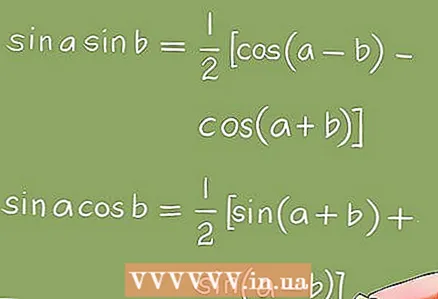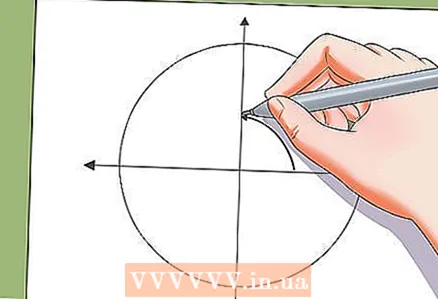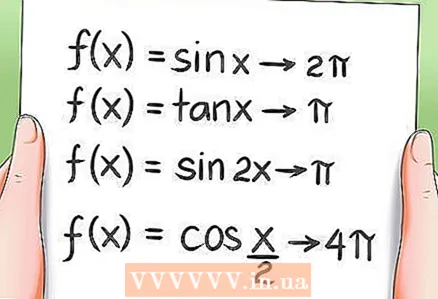Author:
Marcus Baldwin
Date Of Creation:
16 June 2021
Update Date:
1 July 2024

Content
A trigonometric equation contains one or more trigonometric functions of the variable "x" (or any other variable). Solving a trigonometric equation is finding such a value "x" that satisfies the function (s) and the equation as a whole.
- Solutions to trigonometric equations are expressed in degrees or radians. Examples:
x = π / 3; x = 5π / 6; x = 3π / 2; x = 45 degrees; x = 37.12 degrees; x = 178.37 degrees.
- Note: the values of trigonometric functions from angles, expressed in radians, and from angles, expressed in degrees, are equal. A trigonometric circle with a radius equal to one is used to describe trigonometric functions, as well as to check the correctness of the solution of the basic trigonometric equations and inequalities.
- Examples of trigonometric equations:
- sin x + sin 2x = 1/2; tg x + ctg x = 1.732;
- cos 3x + sin 2x = cos x; 2sin 2x + cos x = 1.
- A trigonometric circle with a radius of one (unit circle).
- It is a circle with a radius equal to one and center at point O. The unit circle describes 4 basic trigonometric functions of the variable "x", where "x" is the angle measured from the positive direction of the X axis counterclockwise.
- If "x" is some angle on the unit circle, then:
- The horizontal axis OAx defines the function F (x) = cos x.
- The vertical axis OBy defines the function F (x) = sin x.
- The vertical axis AT defines the function F (x) = tan x.
- The horizontal axis BU defines the function F (x) = ctg x.
- The unit circle is also used to solve basic trigonometric equations and inequalities (different positions of "x" are considered on it).
Steps
 1 The concept of solving trigonometric equations.
1 The concept of solving trigonometric equations.- To solve a trigonometric equation, convert it to one or more basic trigonometric equations. Solving a trigonometric equation ultimately comes down to solving four basic trigonometric equations.
 2 Solving basic trigonometric equations.
2 Solving basic trigonometric equations.- There are 4 types of basic trigonometric equations:
- sin x = a; cos x = a
- tg x = a; ctg x = a
- Solving basic trigonometric equations involves looking at the different x positions on the unit circle and using a conversion table (or calculator).
- Example 1.sin x = 0.866. Using a conversion table (or calculator), you get the answer: x = π / 3. The unit circle gives another answer: 2π / 3. Remember: all trigonometric functions are periodic, that is, their values are repeated. For example, the periodicity of sin x and cos x is 2πn, and the periodicity of tg x and ctg x is πn. Therefore, the answer is written as follows:
- x1 = π / 3 + 2πn; x2 = 2π / 3 + 2πn.
- Example 2.cos x = -1/2. Using a conversion table (or calculator), you get the answer: x = 2π / 3. The unit circle gives another answer: -2π / 3.
- x1 = 2π / 3 + 2π; x2 = -2π / 3 + 2π.
- Example 3.tg (x - π / 4) = 0.
- Answer: x = π / 4 + πn.
- Example 4. ctg 2x = 1.732.
- Answer: x = π / 12 + πn.
 3 Transformations used to solve trigonometric equations.
3 Transformations used to solve trigonometric equations.- To transform trigonometric equations, algebraic transformations (factorization, reduction of homogeneous terms, etc.) and trigonometric identities are used.
- Example 5. Using trigonometric identities, the equation sin x + sin 2x + sin 3x = 0 is transformed into the equation 4cos x * sin (3x / 2) * cos (x / 2) = 0. Thus, you need to solve the following basic trigonometric equations: cos x = 0; sin (3x / 2) = 0; cos (x / 2) = 0.
 4 Finding angles from known values of functions.
4 Finding angles from known values of functions.- Before learning methods for solving trigonometric equations, you need to learn how to find angles from known values of functions. This can be done using a conversion table or calculator.
- Example: cos x = 0.732. The calculator will give the answer x = 42.95 degrees. The unit circle will give additional angles, the cosine of which is also 0.732.
 5 Set the solution aside on the unit circle.
5 Set the solution aside on the unit circle.- You can defer the solutions to the trigonometric equation on the unit circle. The solutions of the trigonometric equation on the unit circle are the vertices of a regular polygon.
- Example: The solutions x = π / 3 + πn / 2 on the unit circle are the vertices of a square.
- Example: The solutions x = π / 4 + πn / 3 on the unit circle represent the vertices of a regular hexagon.
 6 Methods for solving trigonometric equations.
6 Methods for solving trigonometric equations.- If a given trig equation contains only one trig function, solve that equation as the basic trig equation.If a given equation includes two or more trigonometric functions, then there are 2 methods for solving such an equation (depending on the possibility of its transformation).
- Method 1.
- Convert this equation to an equation of the form: f (x) * g (x) * h (x) = 0, where f (x), g (x), h (x) are the basic trigonometric equations.
- Example 6.2cos x + sin 2x = 0. (0 x 2π)
- Solution. Using the double angle formula sin 2x = 2 * sin x * cos x, replace sin 2x.
- 2cos x + 2 * sin x * cos x = 2cos x * (sin x + 1) = 0. Now solve the two basic trigonometric equations: cos x = 0 and (sin x + 1) = 0.
- Example 7.cos x + cos 2x + cos 3x = 0. (0 x 2π)
- Solution: Using trigonometric identities, transform this equation into an equation of the form: cos 2x (2cos x + 1) = 0. Now solve the two basic trigonometric equations: cos 2x = 0 and (2cos x + 1) = 0.
- Example 8.sin x - sin 3x = cos 2x. (0 x 2π)
- Solution: Using trigonometric identities, transform this equation into an equation of the form: -cos 2x * (2sin x + 1) = 0. Now solve the two basic trigonometric equations: cos 2x = 0 and (2sin x + 1) = 0.
- Method 2.
- Convert the given trigonometric equation to an equation containing only one trigonometric function. Then replace this trigonometric function with some unknown, for example, t (sin x = t; cos x = t; cos 2x = t, tg x = t; tg (x / 2) = t, etc.).
- Example 9.3sin ^ 2 x - 2cos ^ 2 x = 4sin x + 7 (0 x 2π).
- Solution. In this equation, replace (cos ^ 2 x) with (1 - sin ^ 2 x) (by identity). The transformed equation is:
- 3sin ^ 2 x - 2 + 2sin ^ 2 x - 4sin x - 7 = 0. Replace sin x with t. The equation now looks like this: 5t ^ 2 - 4t - 9 = 0. This is a quadratic equation with two roots: t1 = -1 and t2 = 9/5. The second root t2 does not satisfy the range of values of the function (-1 sin x 1). Now decide: t = sin x = -1; x = 3π / 2.
- Example 10.tg x + 2 tg ^ 2 x = ctg x + 2
- Solution. Replace tg x with t. Rewrite the original equation as follows: (2t + 1) (t ^ 2 - 1) = 0. Now find t and then find x for t = tg x.
- If a given trig equation contains only one trig function, solve that equation as the basic trig equation.If a given equation includes two or more trigonometric functions, then there are 2 methods for solving such an equation (depending on the possibility of its transformation).
 7 Special trigonometric equations.
7 Special trigonometric equations.- There are several special trigonometric equations that require specific transformations. Examples:
- a * sin x + b * cos x = c; a (sin x + cos x) + b * cos x * sin x = c;
- a * sin ^ 2 x + b * sin x * cos x + c * cos ^ 2 x = 0
 8 Periodicity of trigonometric functions.
8 Periodicity of trigonometric functions.- As mentioned earlier, all trigonometric functions are periodic, that is, their values are repeated after a certain period. Examples:
- The period of the function f (x) = sin x is 2π.
- The period of the function f (x) = tan x is equal to π.
- The period of the function f (x) = sin 2x is π.
- The period of the function f (x) = cos (x / 2) is 4π.
- If the period is specified in the problem, calculate the value of "x" within this period.
- Note: Solving trigonometric equations is not an easy task and often leads to errors. So check your answers carefully. To do this, you can use a graphing calculator to plot the given equation R (x) = 0. In such cases, solutions will be presented as decimal fractions (that is, π is replaced by 3.14).
- As mentioned earlier, all trigonometric functions are periodic, that is, their values are repeated after a certain period. Examples:



